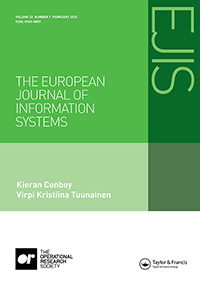Digital governance mechanisms and principles that enable agile responses in dynamic competitive environments
IF 8.6
2区 管理学
Q1 COMPUTER SCIENCE, INFORMATION SYSTEMS
引用次数: 9
Abstract
ABSTRACT Being an agile company today is no longer just about timely recognition of early signs of change in order to defend an existing competitive position but rather being able to perpetually transition between a series of short-lived, temporary competitive advantages. While traditional IT governance approaches have lent themselves well to extracting value from a long-lasting competitive advantage, they can become a liability if agile companies need to continuously reinvent themselves in pursuit of a new, “transient” competitive advantage. To that end, a temporal dimension of IT governance (when and how fast to decide) becomes as important as its structural (who decides what) and procedural (how to decide) aspects. In this paper, we adopt a “ternary” view on governance and build on the extant literature in IS, strategy, and organisation design as well as exemplar case studies to explore how traditional approaches to IT governance structures, processes, and relational mechanisms are altered to improve sensing, deciding, and responding capabilities in turbulent business environments. These mechanisms are then summarised into four digital governance principles to guide future research and practice. Those principles are: 1) disciplined autonomy, 2) IS-Business convergence, 3) permeable boundaries, and 4) incremental financial commitment including fast experimentation.在动态竞争环境中实现敏捷响应的数字治理机制和原则
如今,成为一家敏捷公司不再仅仅是为了捍卫现有的竞争地位而及时识别变化的早期迹象,而是能够在一系列短暂的、暂时的竞争优势之间不断转换。虽然传统的IT治理方法可以很好地从长期的竞争优势中提取价值,但如果敏捷公司需要不断地重塑自己以追求新的、“短暂的”竞争优势,它们可能会成为一种负担。为此,IT治理的时间维度(何时以及以多快的速度决定)变得与其结构方面(谁决定什么)和过程方面(如何决定)一样重要。在本文中,我们采用了治理的“三元”观点,并以IS、战略和组织设计方面的现有文献以及范例案例研究为基础,探索如何改变IT治理结构、流程和关系机制的传统方法,以提高在动荡的商业环境中的感知、决策和响应能力。然后将这些机制总结为四个数字治理原则,以指导未来的研究和实践。这些原则是:1)自律,2)IS-Business融合,3)可渗透的边界,以及4)包括快速实验在内的增量财务承诺。
本文章由计算机程序翻译,如有差异,请以英文原文为准。
求助全文
约1分钟内获得全文
求助全文
来源期刊

European Journal of Information Systems
工程技术-计算机:信息系统
CiteScore
23.10
自引率
4.20%
发文量
52
审稿时长
>12 weeks
期刊介绍:
The European Journal of Information Systems offers a unique European perspective on the theory and practice of information systems for a global readership. We actively seek first-rate articles that offer a critical examination of information technology, covering its effects, development, implementation, strategy, management, and policy.
 求助内容:
求助内容: 应助结果提醒方式:
应助结果提醒方式:


